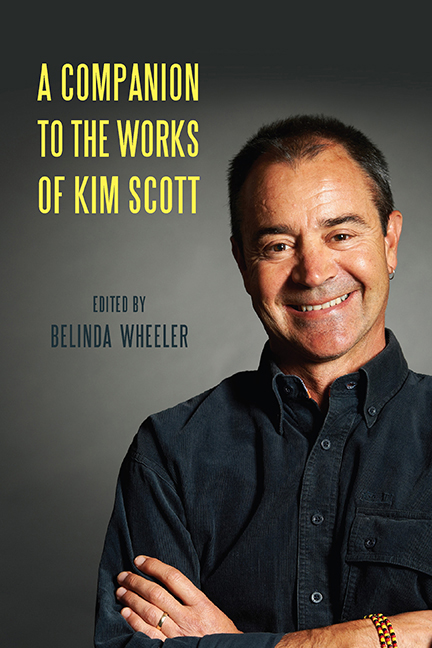Book contents
- Frontmatter
- Contents
- Foreword
- Acknowledgments
- Note on Orthography
- Chronology of Key Writings
- Introduction
- 1 Kim Scott’s Publishing History in Three Contexts: Australian Aboriginal, National, and International
- 2 Kim Scott’s True Country as Aboriginal Bildungsroman
- 3 The Land Holds All Things: Kim Scott’s Benang—A Guide to Postcolonial Spatiality
- 4 Kim Scott’s Kayang and Me: Noongar Identity and Evidence of Connection to Country
- 5 “Wreck/Con/Silly/Nation”: Mimicry, Strategic Essentialism, and the “Friendly Frontier” in Kim Scott’s That Deadman Dance
- 6 The International Reception of Kim Scott’s Works: A Case Study Featuring Benang
- 7 Traumatic Landscapes: Inscribing Spectrality and Identity in Kim Scott’s “A Refreshing Sleep,” “Capture,” and “An Intimate Act”
- 8 Spatial Poetics and the Uses of Ekphrasis in Kim Scott’s “Into the Light” and Other Stories
- 9 The Poetry of Kim Scott
- 10 The Wirlomin Project and Kim Scott: Empowering Regional Narratives in a Globalized World of Literature
- 11 Kim Scott as Boundary Rider: Exploring Possibilities and New Frontiers in Aboriginal Health
- 12 An Interview with Kim Scott
- Notes on the Contributors
- Index
11 - Kim Scott as Boundary Rider: Exploring Possibilities and New Frontiers in Aboriginal Health
Published online by Cambridge University Press: 08 May 2021
- Frontmatter
- Contents
- Foreword
- Acknowledgments
- Note on Orthography
- Chronology of Key Writings
- Introduction
- 1 Kim Scott’s Publishing History in Three Contexts: Australian Aboriginal, National, and International
- 2 Kim Scott’s True Country as Aboriginal Bildungsroman
- 3 The Land Holds All Things: Kim Scott’s Benang—A Guide to Postcolonial Spatiality
- 4 Kim Scott’s Kayang and Me: Noongar Identity and Evidence of Connection to Country
- 5 “Wreck/Con/Silly/Nation”: Mimicry, Strategic Essentialism, and the “Friendly Frontier” in Kim Scott’s That Deadman Dance
- 6 The International Reception of Kim Scott’s Works: A Case Study Featuring Benang
- 7 Traumatic Landscapes: Inscribing Spectrality and Identity in Kim Scott’s “A Refreshing Sleep,” “Capture,” and “An Intimate Act”
- 8 Spatial Poetics and the Uses of Ekphrasis in Kim Scott’s “Into the Light” and Other Stories
- 9 The Poetry of Kim Scott
- 10 The Wirlomin Project and Kim Scott: Empowering Regional Narratives in a Globalized World of Literature
- 11 Kim Scott as Boundary Rider: Exploring Possibilities and New Frontiers in Aboriginal Health
- 12 An Interview with Kim Scott
- Notes on the Contributors
- Index
Summary
THIS CHAPTER WILL COVER another aspect of Kim Scott's scholarly career, namely, his contribution to the expanding field of Aboriginal health while working in the academy within the Faculty of Health Sciences at Curtin University from 2009 to 2012. The ongoing and substantial disparities in health between Aboriginal and non-Aboriginal Australians are well documented and it is recognized that the disappointingly small number of Aboriginal health professionals must increase. Furthermore, the longstanding concerns of Aboriginal people about how they are treated in the health care system have demanded closer scrutiny of relevant content in medical and health science curricula. Reform of health professional training to ensure graduates have the ability to practice in a way that delivers optimal care to Aboriginal people is required.
While working in health sciences, Scott facilitated the exposure of academic and other staff to Aboriginal cultures by coordinating bush camps, and he led the development of curriculum changes as part of the introduction of a compulsory Aboriginal unit in all health science programs. He coedited a textbook on Aboriginal health and cultures, built bridges between faculties and schools, and mentored Aboriginal tutors new to tertiary teaching. This occurred at a time when the number of Aboriginal staff working within the faculty was beginning to increase from a very low base and there was greater awareness and celebration of Aboriginal cultures. This chapter explores these initiatives within the context of the health sciences, where new personalities, egos, networks, and understandings all had to be carefully negotiated.
A Bit of an Academic Interloper
When Scott took up an academic appointment at Curtin University in 2009, it was not part of a carefully planned career move. His PhD in creative writing at the University of Western Australia was nearing completion. The pragmatic reason for accepting an academic and leadership position within the Faculty of Health Sciences was that his student scholarship was ending along with the studies that had occupied his life for the last few years. While language revitalization work was ongoing, funds were limited, and the novel that formed the centrepiece of his thesis, That Deadman Dance (2010), was being prepared for publication.
- Type
- Chapter
- Information
- A Companion to the Works of Kim Scott , pp. 146 - 157Publisher: Boydell & BrewerPrint publication year: 2016

